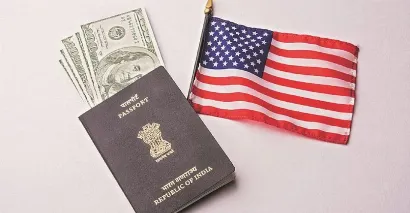Key Highlights
- Background: What Is the New H-1B Fee?
- The Lawsuit: Who’s Suing, and On What Grounds?
- Impacts on U.S. Businesses and the Economy
- Counterarguments & Administration’s Defense
- Legal and Political Landscape
- Why India and Indian Professionals Should Care
- What This Means for the Future of U.S. Immigration Policy
- Conclusion
The U.S. Chamber of Commerce has also sued the Trump administration over a new fee for H-1B visas of 100,000 annually that was introduced recently. The Chamber claims such a fee is beyond the powers of the executive branch and would add extreme pressure to companies that require skilled foreign talent. As H-1B visa recipients are overly represented in the technological, engineering, and essential industries, especially in countries such as India, the consequences of this litigation are vast not only to the employers but also to future employees and the U.S. innovation landscape as a whole.
Background: What Is the New H-1B Fee?
Over the past few months, the Trump administration proposed a record-high fee of $100,000 for a single-year new H-1B visa application. In the past, the application fees for H-1B were significantly smaller, normally less than $3,600 in overall expenses. The administration defended the fee, citing reasons that there are employers who are substituting the U.S. labour force with cheaper foreign talent.
Although the fee is scheduled to take one year by default, it may be renewed in case it is considered to be in the national interest. The administration has also made exemptions for existing visa holders and allowed an employer to petition for relief.
Also Read: How Many Types of Visa in the USA? New Full Expert Guide
The Lawsuit: Who’s Suing, and On What Grounds?
Who is suing and on what grounds:
The Plaintiff and Defendants
The complainant is the U.S. Chamber of Commerce on behalf of numerous corporations, particularly in the field of technology, that use skilled foreign employees. These agencies of the Trump administration (Department of Homeland Security (DHS), the Department of State) and the corresponding cabinet secretaries have become the intended defendants.
Legal Claims
The complaint contends:
-
The President has no right to charge fees which are contrary to the laws enacted by Congress concerning immigration.
-
The charge contravenes the current immigration regulation that the fee to be charged is pegged to the reasonable expenses that the government will incur in order to process the visa.
-
The fee would seriously damage businesses if it were imposed, and they would have to raise labour expenses or reduce the number of skilled foreign employees.
The Chamber wants the court to find the fee illegal and provide an injunction against its enforcement.
Impacts on U.S. Businesses and the Economy
The impacts on US businesses and the economy are:
Burden on Employers
The difference between a few thousand dollars and 100,000 per visa is enormous to the companies that require talented employees, especially the tech ones. Companies complain that the regulation would kill the employment potential, reduce the rate of expansion, and outsource key initiatives to foreign countries.
Effect on Talent Flow
A huge number of H-1B visas is allocated to Indian nationals, particularly in technological spheres. This drastic cost rise can mean reduced opportunities or entry barriers for many Indian and other foreign skilled workers into the U.S. labour market.
Broader Economic Consequences
Limited availability of international talent has the potential to undermine U.S. innovation, R&D, and emerging technology competitive advantage. Major jobs in the engineering sector, data science, biomedical, and academia can encounter bottlenecks during recruitment.
Ripple Effects on Education and Migration
Potential students and young professionals in other countries might re-evaluate taking up American opportunities and move to other alternative markets (Canada, Europe, Asia). The visa policy change can also impact on the long-term immigration planning and human capital flows globally.
Also Read: Cost of Transit Visa for USA: New Fees & Process Guide
Counterarguments & Administration’s Defense
The counterargument and administration's defence were:
Justification for the Fee
The administration justifies the fee by claiming that they are trying to reduce the displacement of American workers by foreign workers. It claims that there are instances where foreigners are hired at lower wage rates or demoralise American employees.
Exemptions and Relief Mechanisms
In a bid to cushion the impact, the administration has announced that holders of the H-1B visa will be exempted, and other employers can seek exemptions.
Authority Over Immigration
The administration asserts an extensive executive power over the regulation of non-citizen admissions and visa regulations that it could invoke to justify the charge of the fee. The Chamber is, however, arguing that this power is constrained in cases where a statutory law goes against an executive action.
Legal and Political Landscape
The legal and political landscape is:
Case Prospects
The lawsuits will depend on whether or not the executive action exceeded statutory authority in the view of the courts. Precedent implies that the courts will question whether the fee is in line with the legislative framework of Congress.
Political Stakes
The case comes at a time when tension has been high on immigration policymaking and executive authority. It puts the interests of business and the technology industry against a governmental administration that is advancing tougher labour and visa regulations.
Possible Outcomes
-
The court may revisit the case and overturn the fee or prevent its enforcement in case the Chamber is correct.
-
With a successful constitutional ruling, the fee could stand, but appeals or countermeasures by legislation could be taken afterwards.
-
The fee could be stayed pending the case as an interim injunction.
Why India and Indian Professionals Should Care
Why Indian professionals should care:
-
High H-1B Visa Exposure: Indian nationals are given a huge portion of approvals to H-1B in the American technology and other related industries. Any kind of system disruption will strike opportunities of many.
-
Career and Mobility: The professionals who are planning to relocate or to work in the U.S. can encounter more barriers or cost burdens.
-
Strategic Alternatives: A shift can drive the talent to other nations with more attractive visa regimes (e.g. Canada, Australia).
-
Implications on Indian IT Firms: Indian IT and export companies that are dependent on the talent placements of the U.S. may be facing increased operational costs and narrowed margins.
Also Read: Difference Between B1 and B2 Visa USA: Experts New Guide
Timeline & Key Players
The timeline and key players are:
Key Timeline of Events
-
Prior to Change: With the old policy, the average employer fees related to H-1B visas were about 3,600 dollars, which comprised processing and application fees.
-
Announcement: The Trump administration declared a drastic increment, and a new H-1B fee of 100,000 annual applications was added to the list of novice applications, arguing that it was a step to safeguard American workers.
-
Legal Filing: The U.S. Chamber of Commerce went on to file a case in the court of law against the Department of Homeland Security (DHS), the Department of State, and some of the key cabinet secretaries, contesting the legality of the new fee.
-
Exemptions: The administration made it clear that current H-1B visa holders were not going to be subject to this and proposed an exception mechanism to employers who need relief over the exorbitant fee.
-
Court Decision (Future): The case has not been resolved yet in federal court. Depending on judicial interpretation of executive power, the consequences may be an injunction, termination or affirmed fee.
Key Players Involved
-
U.S. Chamber of Commerce: The plaintiff in the case is the representative of thousands of businesses that require skilled foreign talent.
-
Trump Administration: The policy initiator, and its immigration strategy aims at protecting local labour markets.
-
Department of Homeland Security (DHS): Named defendant in the regulation and implementation of visas.
-
Department of State: It is a significant participant in the policy implementation and visa processing.
-
Major Tech Companies: Large tech companies such as Amazon, Microsoft, and Google have much to lose because the H-1B holders constitute an important part of their workforce.
-
U.S Congress: Congress is not officially part of the case, but through legislation, it may step in to create bigger visa reform debates in case the court ruling provokes them.
What This Means for the Future of U.S. Immigration Policy
The case might provide a precedent regarding the extent to which executive power can go to re-arrange visa regimes. Assuming success, the suit filed by the Chamber could discourage future administrations from imposing excessive visa charges without support in the form of legislation. In its turn, such a decision, in case it is not reversed, would encourage future executives to re-examine the prices of visas, quotas, or eligibility requirements through administrative fiat.
To companies and international talents, the largest immediate impact is uncertainty. Hiring choices and long-term strategy choices, as well as investment choices, can switch as the future prospects of law or policy reversals. Radical modifications in visa fee systems may turn into a new immigration control stick.
Conclusion
The case filed by the U.S. Chamber of Commerce against the Trump administration in the case of the lawsuit against the administration of the H-1B visa fee of $100,000 can be viewed as an important conflict of balancing immigration policymaking, executive powers, and business interests. The result could transform the way the visa regimes are managed, the mobility of the global talent to the U.S. and the fees that firms incur to remain competitive. The stakes involved are deep for people in Indian and world tech circles, not only in terms of individual career paths, but also of the way the U.S. makes itself an innovation and talented hub in the future.
Contact TerraTern for more information.








